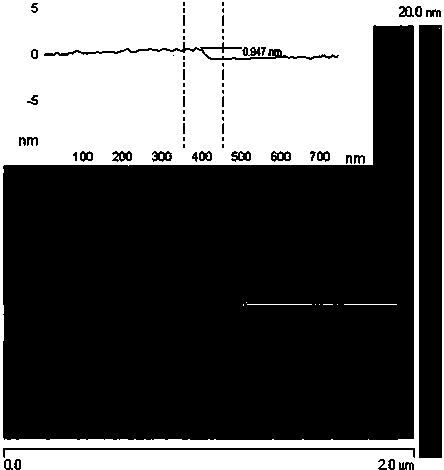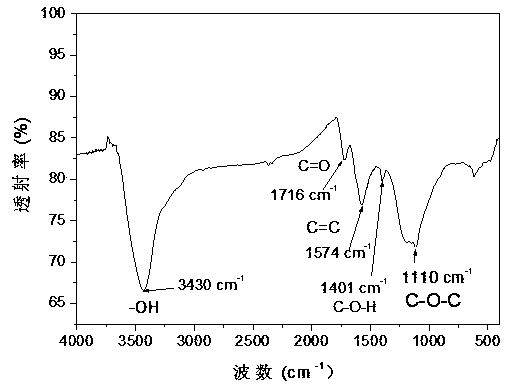Method for adsorbing and separating low-concentration rare earth ions with oxidized graphene colloid
A rare earth ion, adsorption and separation technology, applied in the fields of resource recovery and water environment treatment, can solve the problems of complex synthesis process of magnetic composite particles, difficult to scale practical application, secondary pollution of adsorbents, etc., to achieve convenient regeneration and recycling, The effect of reducing the amount of solid-liquid separation and efficient desorption
- Summary
- Abstract
- Description
- Claims
- Application Information
AI Technical Summary
Problems solved by technology
Method used
Image
Examples
Embodiment 1
[0029] Based on the mechanism (such as Figure 6 shown), put 9 adsorption units (dialysis bags with 10 ml 0.1mg / ml graphene oxide colloid, the same adsorption units used in the following examples) into conical flasks respectively, and add pH = 5.86 Contains Gd 3+ 25 ml of the adsorbed solution of 12 μg / ml was placed in a constant temperature shaking tank in a water bath at a constant temperature of 30°C for oscillating adsorption. After 40 minutes (begin to do tentative experiments, analyze the influence of time on adsorption, adjust the time interval continuously, and take the most suitable time interval), take the adsorbed solution, and measure the residual Gd in the solution with azoarsenic III spectrophotometry 3+ Concentration (measured by absorbance, according to Gd 3+ Calculate the unadsorbed Gd from the standard curve 3+ amount), the Gd that has been adsorbed by graphene oxide was calculated by subtraction method 3+ After the amount of Gd 3+ The amount of adsorpti...
Embodiment 2
[0031] Put 7 adsorption units into Erlenmeyer flasks respectively, add 12 μg / ml Gd respectively 3+ 25 ml of the solution to be adsorbed, adjust the pH of the solution = 2.0, 3.4, 4.5, 5.9, 7.0, 9.0 and 10.00 respectively, place it in a constant temperature oscillation tank in a water bath, oscillate and absorb at a constant temperature of 30°C for 30 minutes, (this time is based on the adsorption time determined in Example 2 Saturation time), until the adsorption is saturated, take the adsorbed solution, and use the azoarsenic III spectrophotometric method to measure the residual Gd in the solution 3+ The concentration of Gd that has been adsorbed by graphene oxide was calculated by subtraction method 3+ After the amount of Gd 3+ The adsorption amount and adsorption rate are plotted against the pH value of the solution, and the curves of the adsorption amount and adsorption rate with the pH value of the solution are obtained, such as Figure 8 shown.
Embodiment 3
[0033] Put the 7 adsorption units into the Erlenmeyer flasks respectively, and add the Gd-containing 3+ 25 ml of 100 μg, 200 μg, 300 μg, 400 μg, 500 μg, 700 μg and 900 μg of the adsorbed solution with pH=5.86, placed in a water bath constant temperature oscillation tank, oscillating at a constant temperature of 30°C for 30 min, and taking the adsorbed solution, Spectrophotometric Determination of Residual Gd in Solution by Azo Arsenic Ⅲ 3+ The concentration of Gd that has been adsorbed by graphene oxide was calculated by subtraction method 3+ After making the amount of graphene oxide at 30 °C for Gd 3+ The adsorption capacity and adsorption rate vary with Gd 3+ initial concentration (C 0 ) change curve, such as Figure 9 shown. Other conditions are exactly the same, for the three groups of Gd 3+ For the adsorbed solution, repeat the above experiment at 30°C, 50°C and 70°C respectively (each group consists of 25 ml pH=5.86 containing Gd 3+ 9 solutions of 50μg, 100μg, 150...
PUM
| Property | Measurement | Unit |
|---|---|---|
| thickness | aaaaa | aaaaa |
| adsorption capacity | aaaaa | aaaaa |
Abstract
Description
Claims
Application Information
 Login to View More
Login to View More - R&D
- Intellectual Property
- Life Sciences
- Materials
- Tech Scout
- Unparalleled Data Quality
- Higher Quality Content
- 60% Fewer Hallucinations
Browse by: Latest US Patents, China's latest patents, Technical Efficacy Thesaurus, Application Domain, Technology Topic, Popular Technical Reports.
© 2025 PatSnap. All rights reserved.Legal|Privacy policy|Modern Slavery Act Transparency Statement|Sitemap|About US| Contact US: help@patsnap.com



